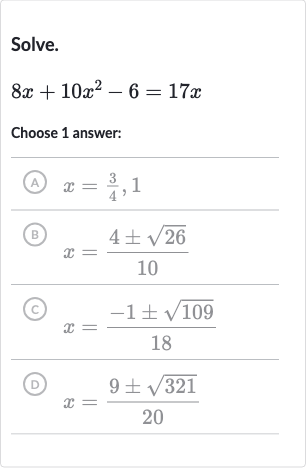AI tutor
Full solution
Q. Solve.Choose answer:(A) (B) (C) (D)
- Rearrange the equation: First, we need to rearrange the equation into standard quadratic form, .The given equation is .Subtract from both sides to get .
- Identify the coefficients: Now, identify the coefficients , , and from the quadratic equation .Here, , , and .
- Use the quadratic formula: Next, we will use the quadratic formula to find the solutions for x, which is . Substitute , , and into the formula.
- Calculate the discriminant: Now, calculate the discriminant, which is the part under the square root in the quadratic formula: .Discriminant = .
- Find the solutions for : With the discriminant calculated, we can now find the two solutions for ..
- Simplify the solutions: Simplify the solutions for
x x x = 9 ± 321 20 . x = \frac{{9 \pm \sqrt{{321}}}}{20}. - Choose the correct answer: The solutions are in the form that matches one of the answer choices provided.
\newline x = 9 ± 321 20 x = \frac{9 \pm \sqrt{321}}{20}
More problems from Solve a quadratic equation using the quadratic formula
QuestionGet tutor help
QuestionGet tutor help
QuestionGet tutor help
QuestionGet tutor help
QuestionGet tutor help
QuestionGet tutor help
QuestionGet tutor help
QuestionGet tutor help
QuestionGet tutor help

